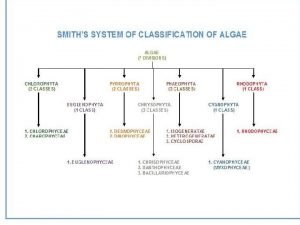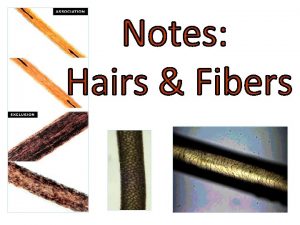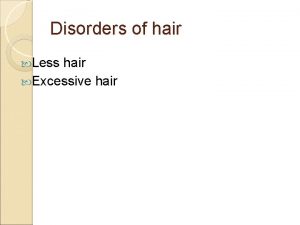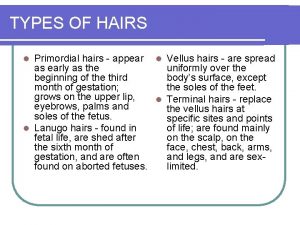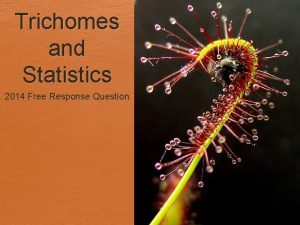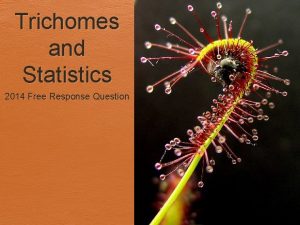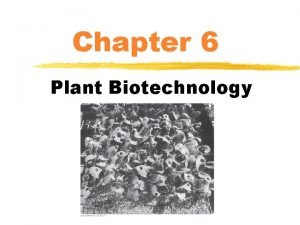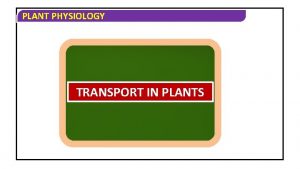Plant hairs or trichomes Plant hairs are called




























- Slides: 28

Plant hairs or trichomes Plant hairs are called trichomes (pronounced: try-combs). Some trichomes are factories that produce different types of chemicals that provide flavors, have medicinal properties, or are used in household items. In many herbs, such as oregano, the trichomes are sunken into the surface of the leaf.

Plant trichome types and forms Plant trichomes originate from the plant epidermis. They all come in a variety of shapes and forms. Examples: Arabidopsis - single-celled trichomes Purple passion plants – multi-celled trichomes Tomato – different types of glandular trichomes

The mouse-ear cress (Arabidopsis thaliana) has single-celled multi-pointed trichomes that project from the outer layer of cells. Interestingly, the cells of these trichomes are polyploid.

The purple passion plant has multicellular trichomes that contain a purple pigment.

The cultivated tomato (Solanum lycopersicum) has four different types of trichomes. Some of these are glandular with globular heads on a short stalk. The globular portion is composed of secretory cells that contain chemicals.

Trichomes as protection Trichomes deter chewing insects, caterpillars, and fungal infections. They also help prevent damage from frost, drought, and UV light.

Trichomes as deterrents Trichomes deter chewing insects, caterpillars, and fungal infections. They also help prevent damage from frost, and drought. Examples: African violet Catnip Petunia

African violet (Saintpaulias sp. ) has dense pointed trichomes on the leaf surface. The clear trichomes shown here contain chemicals that absorb UV light and act as a sunscreen.

Catnip (Nepeta cataria) has pointed trichomes all over the surface of the leaf.

Petunia (Petunia hybrida) has roundtipped trichomes filled with sticky substances that deter insects.

Confocal/fluorescence microscopy of trichomes. Some trichomes contain chemical that absorb the UV light and then emit blue light (or fluoresce) when viewed with the confocal/fluorescence microscope. This is called autofluorescence because it occurs with the plant’s natural chemicals and does not require any staining.

In this Arabidopsis trichome, a beam of UV light is absorbed by a chemical which fluoresces a blue color. Also, note that the chlorophyll in chloroplasts also fluoresces pink, when excited with light ~465 nm.

In confocal/fluorescence microscopy, a series of 4 -7 µm optical sections is merged to provide the entire image of the trichome. Focusing through a plant hair. Merged image.

Trichomes protect plants from UV light. UV-absorption protect plants from UV light acting as a type of sunscreen. The following images show confocal imaging of the trichomes for: Arabidopsis Catnip Pumpkin Soybean African violet Oregano Purple passion plant

Catnip (Nepeta cataria) has pointed trichomes and round (pellate) trichomes embedded in the leaf surface. Both types of trichomes fluoresce blue under the confocal microscope.

African violet (Saintpaulias sp. ) has dense pointed trichomes on the leaf surface. The clear trichomes shown here contain chemicals that absorb UV light and act as a sunscreen.

Trichomes of the purple passion plant (Gynura aurantiaca) fluoresce blue under UV light, while the purple pigment fluoresces bright pink.

Pumpkin (Cucurbita pepo) has short, sharp trichomes. The trichome tips fluoresce brightly.

Oregano (Origanum vulgare) has hairs along its leaf veins and sunken trichomes, both fluoresce blue.

Soybean (Glycine max) has long thin multicellular trichomes, which fluoresce blue.

Unique Trichomes Some trichomes have interesting shapes for other uses. Examples: Salvinia – an aquatic plant Sundew – a carnivorous plant

Salvinia (Salvinia sp. ) has tree or hand-shaped trichomes on the top of the leaf. These trichomes hold air pockets and prevent the leaves from being submerged.

Sundew (Drosera sp. ) are carnivorous plants. The red-tipped trichomes lure insects to the leaves. The sticky trichomes trap the insects and make enzymes that digest them, providing nitrogen to the plant.

Trichomes as biochemical factories. Trichomes that produce different types of chemicals, often have been useful to humans. The chemicals provide flavors, have medicinal properties, or are used in household items. Flavor q Menthol q Carvacrol (oregano) q Eucalyptol q Steviol (in stevia) q Essential oils Household Medicinal q q Antioxidants Antimicrobials Antimalarial Cannabinoids q q Limonene Cotton fibers Pinene Insect deterrents

The trichome from sweet basil are sunken into the epidermis. The confocal image shows that the trichome consists of 4 cells.

In oregano the trichome that contain the chemicals that produce flavor and aroma appear are bright balls sunken into the leaf surface.

References Glas JJ, BCJ Schimmel, JM Alba, R Escobar-Bravo, RC Schuurink, and MR Kant. (2012) Plant glandular trichomes as targets for breeding or engineering of resistance to herbivors. Int. J. Mol. Sci. 13: 17077 -17103 DOI: 10. 3390/ijms 131217077 Sinlapadech T, J Stout, M Ruegger, M Deak, and C Chapple (2007) The hyper-fluorescent trichome phenotype of the brt 1 mutant of Arabidopsis is the result of a defect in a sinapic acid: UDPG glucosyltransferase. Plant Journal. 49(4): 655 -68.

Acknowledgements Marcia Harrison-Pitaniello thanks the John Deaver Drinko Academy at Marshall University for funding her ongoing efforts to develop and publish curricular materials. She also wishes to thank Terry Shank, Angela Kargul, Danielle Gallagher, and Susan Weinstein for their helpful input on this material.
 Antigentest åre
Antigentest åre Hair and fiber evidence worksheet answers
Hair and fiber evidence worksheet answers Head hairs and pubic hairs exhibit a greater range of
Head hairs and pubic hairs exhibit a greater range of Trichomes in algae
Trichomes in algae Stellate trichome
Stellate trichome Hair fibers are composed of
Hair fibers are composed of Plumb line in surveying
Plumb line in surveying Dr paul farrant
Dr paul farrant Hairs and fibers in forensic science
Hairs and fibers in forensic science Medulla hair
Medulla hair Clean edge razor: splitting hairs in product positioning
Clean edge razor: splitting hairs in product positioning Vegetative parts
Vegetative parts House on mango street hairs
House on mango street hairs Parallax may be eliminated by
Parallax may be eliminated by Stadia hairs in surveying
Stadia hairs in surveying Exclamation mark hairs
Exclamation mark hairs Types of herbaceous stems
Types of herbaceous stems Taichum
Taichum Albugo eye
Albugo eye Plant introduction in plant breeding
Plant introduction in plant breeding Tronsmo plant pathology and plant diseases download
Tronsmo plant pathology and plant diseases download Objective of plant breeding
Objective of plant breeding Tronsmo plant pathology and plant diseases download
Tronsmo plant pathology and plant diseases download A bss without an ap is called an
A bss without an ap is called an Assembly language uses easy-to-remember instructions called
Assembly language uses easy-to-remember instructions called What is this called
What is this called Solid to liquid is called
Solid to liquid is called A collection well-defined objects
A collection well-defined objects The online data entry control called preformatting is
The online data entry control called preformatting is



